

Discovering an Integral Civic Consciousness in a Global Age. This essay was originally published in the March 2012 issue of the Journal of Integral Theory and Practice.

Click here to purchase the full issue. This article asks why, in an age of global crisis, global governance still remains a low priority for the integral community. It posits a civic line of development, suggesting only those possessing a worldcentric level of civic awareness can fully comprehend global problems and the need for binding global governance. I argue that modern (orange altitude), postmodern (green altitude), and even low vision-logic (teal altitude) worldviews still see global problems nationcentrically rather than worldcentrically.
I explore this limitation in light of destructive international competition; a key and potentially catastrophic phenomenon that, it is argued, shows why only a worldcentric, late vision-logic (turquoise altitude) civic consciousness can disclose solutions to the global crisis. The Civic Holarchy Integral Civic Consciousness Figure 1. The homepage of Roy Lachica. Forget IQ, Collective Intelligence is the New Measure of Smart (video. We may focus on the stories of individual genius, but it will be harnessing the intelligence of the collective that enables humanity to solve its future problems.

Do you know your IQ, that little number that’s supposed to measure how smart you are? Forget it. Au pire ça marche. Graphic: Collective Intelligence Application Framework. LINKS ON THE PRACTICE AND THEORY OF COLLECTIVE INTELLIGENCE. Links on the practice and theory of collective intelligence, by Pierre Lévy Some of my favorite thinkers (alphabetical order) Henri Atlan: J.

L. TEDxManitoba - TJ Dawe: An Experiment in Collective Intelligence. Collective Intelligence. CI Resources - The Collective Intelligence Blog. Visión Estratégica IMCP : Instituto Mexicano de Contadores Públicos. Home - Doug Engelbart Institute. Don Tapscott. Designing for the Emergence. By George Pór george.por@insead.fr an updated version of paper presented at the Global Brain Workshop, Brussels, July 3-5, 2001 version 01.07.26 Abstract.
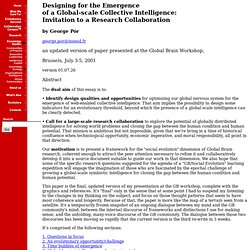
Anthropology – Discovery of Collective Intelligence. The discovery of collective intelligence allowed building a bridge between the archetypes and lifestyles of cultures and the social, institutional and individual behavior.

Individual intelligence is always empowered or inhibited by the lifestyle of a culture which is driven by the fundamentals of the archetype. Collective intelligence is the driver that allows building intelligent synergy among the members of a society to better adapt to the environment. It is easily noticeable in animals, such as ants and rats. Collective-action-design-framework.png (Image PNG, 1371x950 pixels) - Redimensionnée (85%)
Evidence for a Collective Intelligence Factor in the Performance of Human Groups. Collective intelligence, as a field of study and practice, is taking off. Collective intelligence, as a field of study and practice, is taking off Summary: Collective intelligence, as a field of study and practice, is taking off.
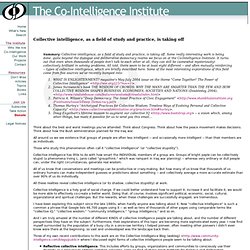
Some really interesting work is being done, quite beyond the dialogue and deliberative democracy realms we focus on at the Co-Intelligence Institute. It turns out that even when thousands of people don't talk to each other at all, they can still be (somewhat mysteriously) collectively brilliant in solving problems. All told, there seem to be at least eight different -- and often mutually reinforcing -- types of collective intelligence, which are briefly described here. Colligence - Intelligence collective. OSS.Net, Inc. Home Page. Humans, Machines and Collective Intelligence.
Tom Malone gave a very interesting talk on collective intelligence at the IBM Cognitive Systems Colloquium which I recently attended and wrote about.
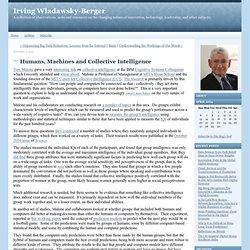
Malone is Professor of Management at MIT’s Sloan School and the founding director of the MIT Center for Collective Intelligence (CCI). His research is primarily driven by this fundamental question: “How can people and computers be connected so that - collectively - they act more intelligently than any individuals, groups, or computers have ever done before?” This is a very important question to explore to help us understand the impact of our increasingly smart machines on the very nature of work and organizations.
Malone and his collaborators are conducting research on a number of topics in this area. Public Intelligence Blog. Fundamentals of Collective Adaptive Systems. Crowdsourcing vs Collective Intelligence. What's the diff? Thanks to intrepid design blogger, oyster fiend, and “bro”, John DiPalma and his solid blog at DesignRising, I’ve been coerced into writing much richer blog posts about the topics that I’m exploring.
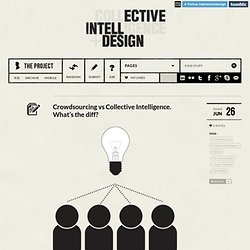
So, here goes the first in a series of attempts to share some meatier topics and the findings that I’m uncovering. The Co-Intelligence Institute. Institut francophone d'intelligence collective - IFIC - Accueil. Evolving Collective Intelligence. Modèles de l'intelligence collective des sociétés. Un article de Wikipédia, l'encyclopédie libre.
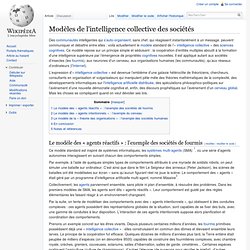
Des communautés intelligentes qui s’auto-organisent, sans chef, qui réagissent instantanément à un message, peuvent communiquer et débattre entre elles : voilà actuellement le modèle standard de l’« intelligence collective » des sciences cognitives. Ce modèle repose sur un principe simple et séduisant : la coopération d’entités multiples aboutit à la formation d’une intelligence supérieure par l’émergence de propriétés cognitives nouvelles. Il est appliqué autant aux sociétés d’insectes (les fourmis), aux neurones d’un cerveau, aux organisations humaines (les communautés), qu’aux réseaux d’ordinateurs (l’Internet).
Le modèle des « agents réactifs » : l’exemple des sociétés de fourmis[modifier | modifier le code] Ce modèle standard est inspiré de systèmes informatiques, les systèmes multi-agents (SMA) [1], où une série d’agents autonomes interagissent en suivant chacun des comportements simples. Participatory wisdom and sustainability. Poolalgosynergizingv1.png (7016x4961) Kasparov versus the World. It is the greatest game in the history of chess.
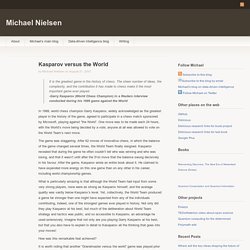
The sheer number of ideas, the complexity, and the contribution it has made to chess make it the most important game ever played. -Garry Kasparov (World Chess Champion) in a Reuters interview conducted during his 1999 game against the World In 1999, world chess champion Garry Kasparov, widely acknowledged as the greatest player in the history of the game, agreed to participate in a chess match sponsored by Microsoft, playing against “the World”. One move was to be made each 24 hours, with the World’s move being decided by a vote; anyone at all was allowed to vote on the World Team’s next move.
The game was staggering. What is particularly amazing is that although the World Team had input from some very strong players, none were as strong as Kasparov himself, and the average quality was vastly below Kasparov’s level. How was this remarkable feat achieved? Microsoft appointed four official advisors to the World Team. Further reading. Collective Intelligence in Human Groups - Anita Williams Woolley. Blog of Collective Intelligence: Spiral Dynamics & the Colors of CI Archives. > all complex civilisations have collapsed at one point or another.
Only 'simple' societies have managed to survive. Just think of nature. Hasn't life been moving towards increasing complexity from the single-cellular to the multi-cellular organism, from worms to mammalians and humans? (To let that really sink in, use the Cellular Complexity painting above, by David Sweatt, as a meditation object. Click on the image to enlarge.
The move towards more complexity doesn't stop in adulthood. Facing the overwhelming complexity of today's world, the "natural" response is to look back and long for a lost "natural rhythm and pace. " I know, it's easier said than done. Vannevar Bush on the new relationship between. Category:Collective intelligence. Global Futures Collective Intelligence System. The Millennium Project is integrating all of its information, groups, and software into a "Global Futures Intelligence System. " GFIS* is The Millennium Project’s new way for you to participate with and have access to all of our resources in one place. Those who buy a one-year subscription can interact with all the elements of the system, make suggestions, initiate discussions with experts around the world, and search through over 10,000 pages of futures research and 1,300 pages of methods. The text has built-in Google translation with 52 languages.
MP Node chairs and content reviewers will have free access. ThinkState. Accueil Intelligence Collective - Vision 2021.